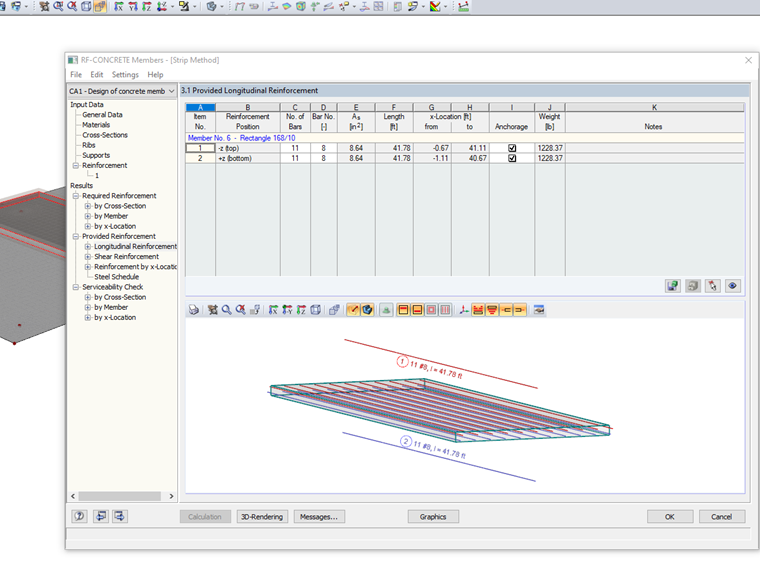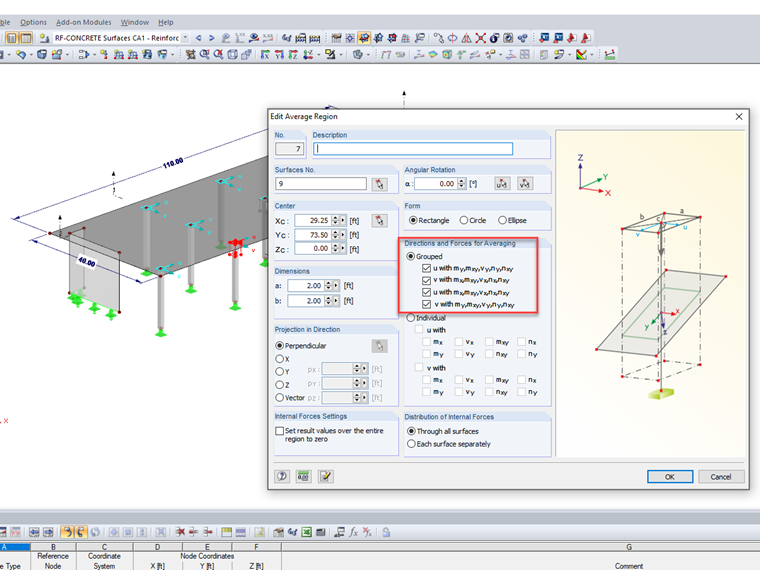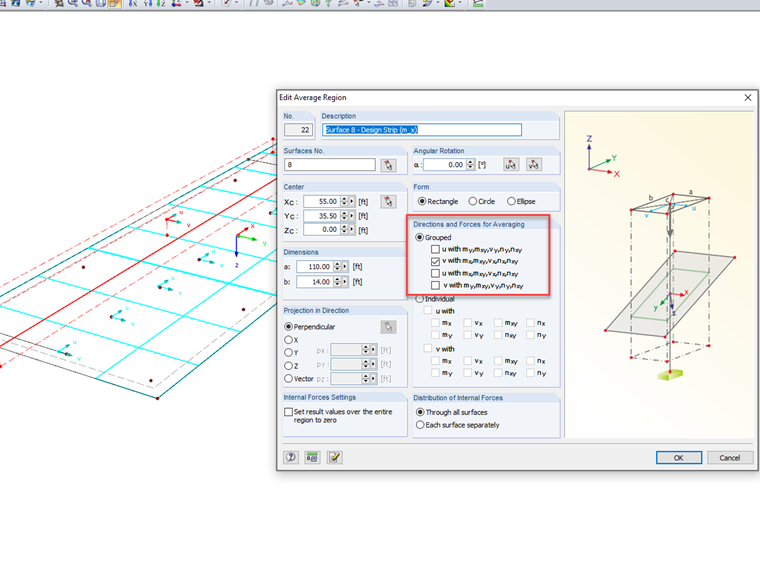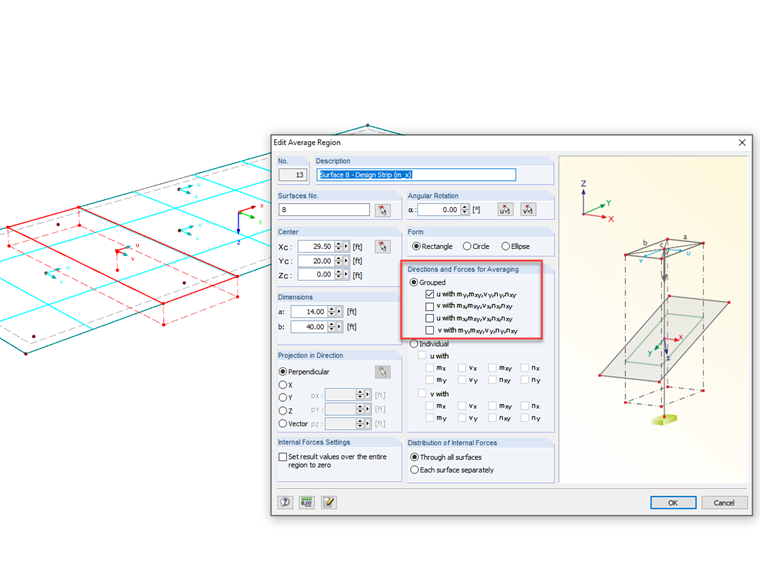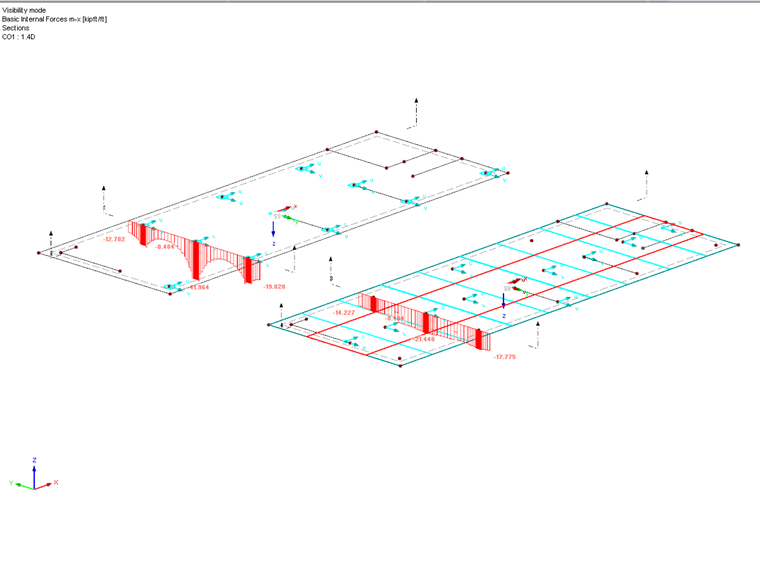ACI 318-19 sec. 8.4.1.5 y 8.4.1.6 recomiendan el uso de pilares y franjas intermedias para el cálculo de losas bidireccionales. Las franjas de pilares incluyen un ancho de 0.25lmin a cada lado de la línea central del pilar. Se coloca una franja central entre dos franjas de columnas. De manera similar, CSA A23.3:19 también especifica anchos de franja de pilares como 0.25lmin, mientras que la franja central es el área delimitada por dos franjas de pilares.
El enfoque en RF-CONCRETE Surfaces
El enfoque de diseño predeterminado en el módulo RF-CONCRETE Surfaces es el diseño de la losa bidireccional. El programa principal de análisis por elementos finitos RFEM ejecuta un análisis de elementos finitos completo para determinar los esfuerzos internos básicos como mx y my para todos los elementos de superficie 2D dentro del modelo. Los esfuerzos internos básicos definidos por los ejes locales de las superficies' (x, y, z) se transforman en esfuerzos internos principales tales como m1 y m2 relacionados con los ejes principales 1 y 2. Se puede encontrar más información sobre esta transformación en el manual en línea de RFEM:
RF-CONCRETE Surfaces calcula además los momentos de cálculo finales para los lados superior e inferior de la placa orientados a lo largo de las direcciones de armadura definidas. Consulte el manual en línea de RF-CONCRETE Surfaces 2.4.1 Esfuerzos internos de cálculo para obtener información detallada sobre este flujo de trabajo de cálculo:
Los momentos de diseño finales se consideran en cada punto de malla de elementos finitos como una franja de 1 pie (o 1 m) de ancho en la dirección de la armadura longitudinal. La armadura a lo largo de esta franja se determina sobre la base de este momento de cálculo junto con las consideraciones de la norma de cálculo, como los mínimos de armadura. Las unidades para la armadura dada son [área/anchura de la armadura], que es in²/ft (o cm²/m). La armadura necesaria en cada punto de la malla de EF se proporciona en la representación gráfica utilizando líneas de contorno de colores.
Los ingenieros pueden estar interesados en considerar un ancho de cálculo mayor en lugar del valor predeterminado de 1 pie (o 1 m), como lo que permite ACI 318-19 o CSA A23.3:19 para un enfoque más simplificado.
Franjas de cálculo con vigas de resultados en RF-CONCRETE Members
Las vigas de resultados tienen la capacidad de sumar todos los esfuerzos internos de un elemento de losa sobre una longitud y anchura elegidas. Las vigas resultantes no contribuyen a la rigidez de la estructura ni influyen en la distribución de carga. Más bien, se pueden utilizar como una herramienta de evaluación de resultados. Consulte el Manual de ayuda en línea de RFEM 4.17 Barras para una explicación detallada de este tipo de barra:
Se puede dibujar una viga de resultados directamente sobre el elemento de losa. El tipo y material de la sección puede ser cualquier selección arbitraria. El tipo de barra se debe establecer en "viga de resultados". Además, se debe seleccionar la opción "Dentro del cuboide - general" con el ancho Y establecido en el ancho total de la franja de cálculo deseada y la altura Z establecida para abarcar el espesor de la superficie. Las superficies sobre las que se extiende la franja de cálculo se deben enumerar en los "Objetos incluidos".
Ver el seminario web de RFEM 2: Modelado avanzado en el tiempo 38:14 para ver un ejemplo similar de una viga de resultados aplicada sobre un elemento de losa.
Las vigas resultantes se pueden calcular en el módulo RF-CONCRETE Members como un elemento de viga típico.
La armadura longitudinal se proporcionará según las normas ACI 318 o CSA A23.3 en función del momento flector medio a lo largo de la longitud de la viga.
Se pueden crear múltiples vigas de resultados en ambas direcciones longitudinales y diseñar en el módulo RF-CONCRETE para aplicar el método de cálculo de franjas unidireccional para elementos de losa. Consulte la superficie 7 y la barra 6 en el modelo de descarga al final del artículo para este ejemplo de viga de resultados.
Franjas de diseño con regiones medias en RF-CONCRETE Surfaces
La alternativa a las vigas de resultados es aplicar regiones medias sobre el ancho de la franja de diseño especificada. Las regiones medias promedian los esfuerzos internos sobre el área designada en un elemento de superficie que se puede considerar para el cálculo en RF-CONCRETE Surfaces. Lea más sobre las regiones medias en el Manual de ayuda en línea de RFEM 9.7.3 Regiones medias:
Las regiones medias son beneficiosas para situaciones de singularidad. Ver artículos adicionales sobre "Regiones medias" en la base de datos de conocimientos:
También se pueden considerar en el módulo RF-CONCRETE Surfaces para suavizar picos altos en esfuerzos internos y tensiones que no ocurrirían en situaciones de la vida real debido a una mejor distribución de carga que un software de análisis por elementos finitos no puede capturar de forma predeterminada. Consulte el seminario web CSA A23.3:19 Cálculo de hormigón en RFEM en el tiempo 56:10 para ver un ejemplo de regiones y singularidades medias para el cálculo de hormigón armado.
Además, la superficie 9 en el modelo de descarga aplica el uso de regiones medias solo alrededor de las intersecciones del pilar con la losa para evitar requisitos de armadura de pico elevados. Los esfuerzos internos se promedian en todas las direcciones en un área de 2 pies ⋅ 2 pies.
Las regiones medias también se pueden usar para replicar franjas de cálculo para consideraciones de armadura. La superficie 8 es idéntica a la superficie 9 en el modelo de descarga. Sin embargo, las franjas de cálculo se aplican a lo largo de todo el ancho y largo de la losa en ambas direcciones X e Y en lugar de solo en las ubicaciones singulares. El ancho de la franja de diseño lo establece el usuario y probablemente considere las recomendaciones de ACI 318 y CSA A23.3.
También es extremadamente importante prestar especial atención a los detalles de "Direcciones y fuerzas para el promedio" en el cuadro de diálogo Editar región media. Las franjas de diseño están diseñadas para el diseño unidireccional. Por lo tanto, las regiones medias solo deberían considerar el promedio de los esfuerzos internos en la dirección correspondiente. Esto se puede establecer alineando el eje local de la región media con el eje local perpendicular de la superficie (por ejemplo, el eje u de la región media's con el eje y de la superficie's). Esta configuración dependerá de la orientación de los elementos en el modelo utilizado. Los esfuerzos internos relevantes se promediarán a lo largo del ancho de la franja de diseño.
La visualización de los esfuerzos internos básicos de las superficies' tales como los momentos flectores en el eje x (mx) muestra una diferencia significativa para los valores predeterminados a lo largo de un corte de sección que incluye esfuerzos máximos elevados (superficie 9) frente a los valores de corte de la sección promediados sobre un promedio anchura de la región (superficie 8).
El cálculo de la armadura en RF-CONCRETE Surfaces puede considerar las regiones medias seleccionando esta opción en la configuración "Detalles" dentro del módulo. El cálculo considerará entonces las regiones medias implementadas en la superficie. Dicho esto, aunque las regiones medias afectarán directamente a los esfuerzos internos básicos a lo largo de los ejes x e y de la superficie, estos no son los valores utilizados para el cálculo final. En su lugar, se utilizan los esfuerzos internos de cálculo finales que se derivaron de los momentos flectores máximos y mínimos no necesariamente orientados a lo largo del eje x e y. No es posible eliminar el cálculo bidireccional en el módulo. Las regiones medias utilizadas como franjas de cálculo proporcionarán una mejor uniformidad para el cálculo de la armadura, pero no son un cálculo unidireccional estricto.
Conclusión
RF-CONCRETE Surfaces es un módulo de cálculo de losas de armadura bidireccional por defecto. La armadura necesaria del análisis se proporcionará tanto en la salida numérica como gráfica en cada punto de la malla de elementos finitos en función de los esfuerzos internos de cálculo finales calculados dentro del módulo. The optimal way to consider the design strip method for true one-way reinforced concrete design over a user-defined width is with the use of result beams and the add-on module <nobr>RF-CONCRETE Members</nobr>. La alternativa es aplicar regiones medias dentro del modelo RFEM y activar esta consideración dentro de RF-CONCRETE Surfaces. La última opción mejorará el promedio de la fuerza interna sobre el ancho de una franja de diseño, pero el diseño en dos direcciones aún se considerará en el proceso de diseño de la armadura.


